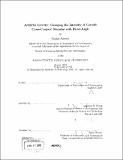| dc.contributor.advisor | Laurence R. Young. | en_US |
| dc.contributor.author | Adenot, Sophie, 1982- | en_US |
| dc.contributor.other | Massachusetts Institute of Technology. Dept. of Aeronautics and Astronautics. | en_US |
| dc.date.accessioned | 2005-09-27T18:57:15Z | |
| dc.date.available | 2005-09-27T18:57:15Z | |
| dc.date.copyright | 2004 | en_US |
| dc.date.issued | 2004 | en_US |
| dc.identifier.uri | http://hdl.handle.net/1721.1/28900 | |
| dc.description | Thesis (S.M.)--Massachusetts Institute of Technology, Dept. of Aeronautics and Astronautics, 2004. | en_US |
| dc.description | Includes bibliographical references (p. 91-94). | en_US |
| dc.description.abstract | Artificial Gravity (AG) created by high-speed rotation is a promising method for preventing the serious deconditioning associated with prolonged exposure to weightlessness. Unfortunately, head-movements in a rotating environment create Coriolis cross-coupled stimuli that introduce problematic vestibular responses. Earlier studies have shown that it is possible to achieve at least partial adaptation to these stimuli, and that side-effects diminish by the end of the training. This thesis seeks to contribute to the understanding of the problem of optimization of and efficiency in AG-training. We tested 14 subjects to see if variations of the angle of head-turn (300, 600, 900), when performed on a 23 rpm short-radius centrifuge, had an effect on adaptation on VOR gain, on time-constant, and on subjective reports (motion sickness, motion illusion and body-tilt). We found that: 1. The pattern of adaptation is different for the time constant r from that of the amplitude of the VOR: higher fractional decreases in r are found at smaller angles, but in peak- and normalized slow-phase velocity, higher fractional decreases are found at higher angles. 2. Small head-angles correspond to small intensity of Coriolis cross-coupled stimulus which leads to less discomfort, i.e. low motion sickness and illusion scores, but also to weaker adaptation. 3. When subjects are already familiar with the AG environment, their VOR amplitudes and time constants are smaller, and show smaller fractional decreases. 4. Subjects feel a(n) (illusory) feet-down tilt after to-nose-up head-turns, but they feel horizontal after to-right-ear-down head-turns. | en_US |
| dc.description.statementofresponsibility | by Sophie Adenot. | en_US |
| dc.format.extent | 120, [17] p. | en_US |
| dc.format.extent | 7820462 bytes | |
| dc.format.extent | 7838201 bytes | |
| dc.format.mimetype | application/pdf | |
| dc.format.mimetype | application/pdf | |
| dc.language.iso | en_US | |
| dc.publisher | Massachusetts Institute of Technology | en_US |
| dc.rights | M.I.T. theses are protected by copyright. They may be viewed from this source for any purpose, but reproduction or distribution in any format is prohibited without written permission. See provided URL for inquiries about permission. | en_US |
| dc.rights.uri | http://dspace.mit.edu/handle/1721.1/7582 | |
| dc.subject | Aeronautics and Astronautics. | en_US |
| dc.title | Artificial gravity : changing the intensity of coriolis cross-coupled stimulus with head-angle | en_US |
| dc.title.alternative | Changing the intensity of coriolis cross-coupled stimulus with head-angle | en_US |
| dc.type | Thesis | en_US |
| dc.description.degree | S.M. | en_US |
| dc.contributor.department | Massachusetts Institute of Technology. Department of Aeronautics and Astronautics | |
| dc.identifier.oclc | 60458790 | en_US |
